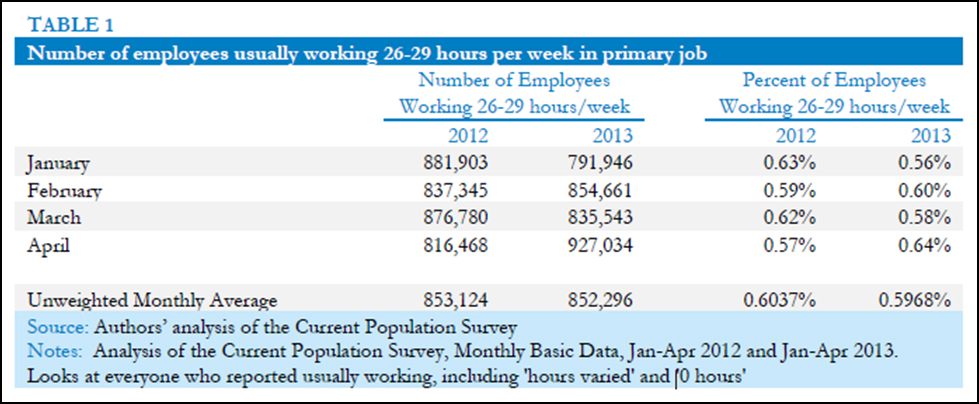July 24, 2013
Opponents of the ACA have labeled the health care bill a “jobs killer.” It is unlikely, however, that the bill could have much impact on employment except among the relatively small number of firms that are near the 50-worker cutoff. In a post for the Roosevelt Institute’s Econobytes, economists Helene Jorgensen and Dean Baker respond to the claim that firms will reduce the number of hours per week that employees work to below thirty so that they fall under the cutoff, thereby incurring a penalty under the ACA:
An analysis of data from the Current Population Survey shows that only a small number (0.6 percent of the workforce) of workers report working just below the 30 hour cutoff in the range of 26-29 hours per week. Furthermore, the number of workers who fall in this category was actually lower in 2013 than in 2012, the year before the sanctions would have applied. This suggests that employers do not appear to be changing hours in large numbers in response to the sanctions in the ACA.
There have been numerous accounts of employers claiming to reduce employment or adjust hours in order to avoid the obligations of the ACA.
- If this is the case, we should have first begun to see evidence of the impact of ACA in January of 2013, since under the original law employment in 2013 would serve as the basis for assessing penalties in 2014.
- The Obama administration announced on July 2, 2013 that they would not enforce sanctions in 2014 based on 2013 employment, but employers would not have known that sanctions would not be enforced prior to this date. Therefore we can assume that they would have behaved as though they expect to be subject to the sanctions and acted accordingly.
Reducing average hours of work below 30 per week, could plausibly have an impact on employment patterns, but the data do not indicate that this is happening.
- Several large employers have claimed that they would deliberately keep workers’ hours below 30 hours per week in order to avoid having them count toward the number for whom they would have a $2,000 penalty.
- Some surveys of small businesses also report that employers intend to reduce workers’ hours to avoid the penalty, even they are not bound by the law.
- Fortunately, it is possible to test whether employers are actually reducing hours below the 30-hour threshold.
- The Current Population Survey (CPS) provides monthly data on workers usual weekly hours. We used the CPS to compare the first four months of 2013 with the first four months of 2012.
- We looked at the numbers and percent of workers who reported working 26-29 hours a week.
- We considered this range a reasonable cutoff for an ACA effect. Presumably if an employer would have a worker put in more than 30 hours a week in the absence of ACA penalties, they would require a worker to put in close to, but less than, 30 hours in order to avoid the penalties.
Table 1 shows the results.

There are two points that are striking. First, a very small share of the workforce falls into this group.
- Well under 1 million workers, roughly 0.6 percent of the labor force, typically work between 26-29 hours a week.
- It is also important to remember that many of these workers choose to work less than a full-time job. More than two-thirds of the workers who report working less than full-time jobs say that they are doing so by choice.
- If this ratio also applies to the workers who usually work between 26-29 hours it would mean that less than 300,000 workers, or roughly 0.2 percent of the workforce, are working this number of hours as a result of their employer’s decision.
The other striking aspect to the data in Table 1 is that the number and percentage of workers putting in between 26-29 hours per week was slightly lower in 2013 than in 2012.
- The average percentage of workers in this category for 2013 was 0.597 percent.
- That is down from 0.604 percent in 2012.
- While this drop is not close to being statistically significant, the change is in the wrong direction for the ACA as job-killer story.
While there may certainly be instances of individual employers carrying through with threats to reduce their employees’ hours to below 30 to avoid the sanctions in the ACA, the numbers are too small to show up in the data.
- It appears that in setting worker hours employers are responding to business considerations in much the same way as they did before the ACA took effect.
- While the sanctions in the ACA may provide some marginal incentive to reduce worker hours below the 30-hour cutoff, other considerations in setting worker hours appear to be far more important.






